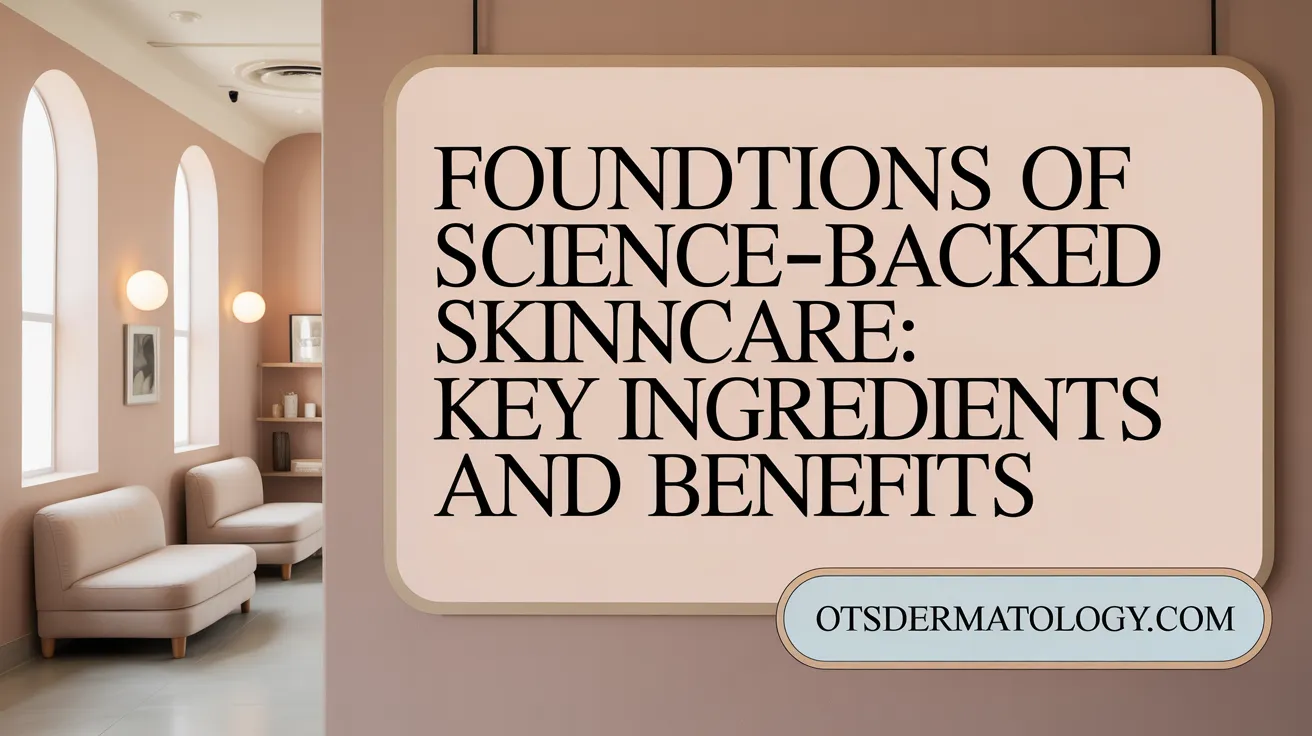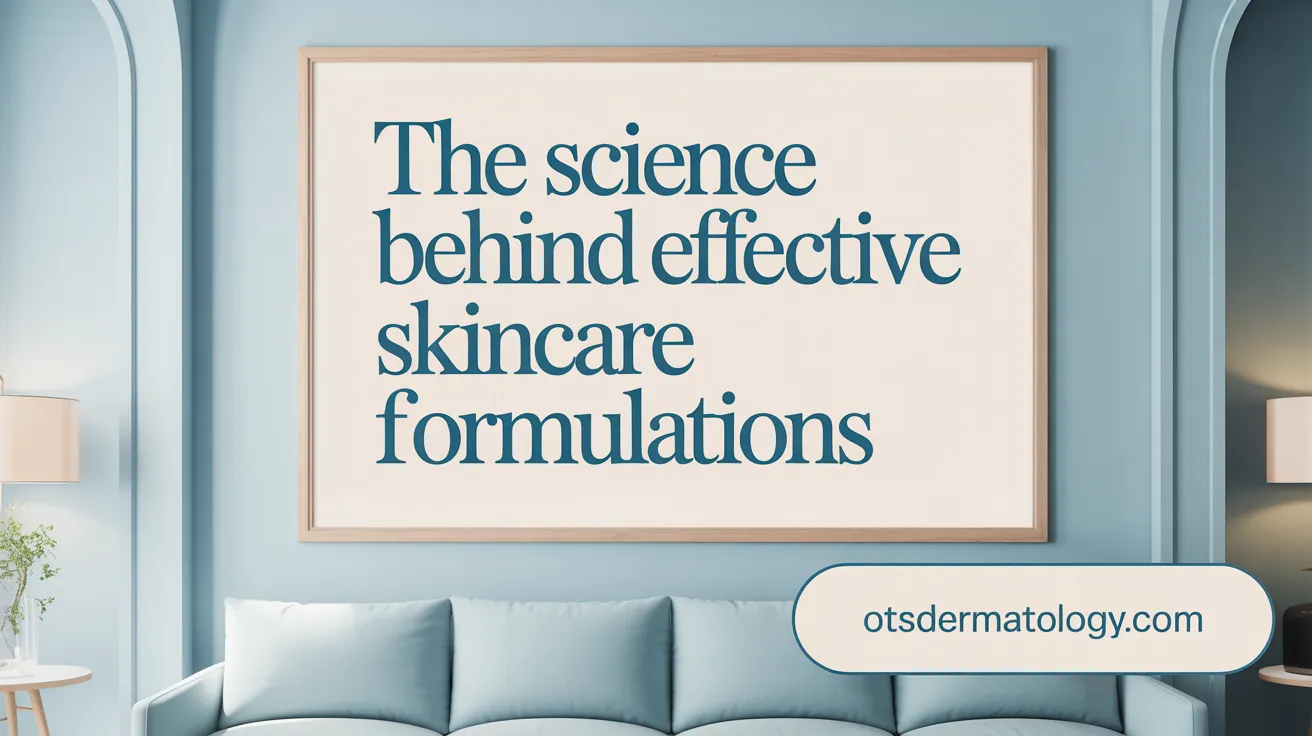Understanding the Power of Proven Skincare Actives
In a beauty landscape cluttered with trendy buzzwords and myriad ingredient claims, scientific research stands as the definitive guide to identifying the most effective skincare ingredients. Consumers and dermatologists alike rely on rigorous clinical studies and molecular insights to distinguish ingredients that truly deliver measurable skin health benefits. This article delves into the validated science behind the top skincare ingredients, exploring their mechanisms, clinical support, and dermatological consensus to empower informed choices grounded in evidence.
The Cornerstones of Scientifically Validated Skincare

How can scientific validation guide consumers in choosing effective skincare products?
Scientific validation is crucial in helping consumers distinguish between products that genuinely deliver benefits and those that are driven by marketing hype. By relying on research-backed skincare ingredients, consumers can identify ingredients proven to improve skin health. For example, hyaluronic acid has been scientifically shown to attract and retain moisture, making skin appear plumper and reducing the appearance of fine lines. Retinol , supported by numerous studies, is effective at increasing collagen production, smoothing skin texture, and reducing wrinkles. Vitamin C, as a powerful antioxidant, not only brightens the skin but also protects it against environmental damage such as pollution and UV rays.
In addition, scientific validation confirms the efficacy of niacinamide in strengthening the skin barrier, reducing redness, and minimizing pores. Exfoliating agents like alpha-hydroxy acids (AHAs) are validated for their ability to remove dead skin cells, leading to smoother skin and improved texture.
This approach ensures that product claims are not just marketing statements but are substantiated by credible scientific evidence. It empowers consumers to make informed choices, favoring products with ingredients that have demonstrated benefits through clinical trials and research. As a result, consumers can avoid wasting money on ineffective products or risking irritation and harm from unproven ingredients.
Overall, scientific validation enhances confidence in skincare routines, helping users select products tailored to their specific concerns while promoting safe and effective skin health practices.
Clinically Proven Benefits of Key Skincare Ingredients
What are the scientifically proven benefits of key skincare ingredients?
Research shows that certain skincare ingredients have strong scientific support for their positive effects on skin health and aging. One of the main benefits is their ability to combat oxidative stress, which is a major driver of skin aging. Ingredients such as vitamin C and vitamin E, coenzyme Q10, carotenoids, and polyphenols act as antioxidants, neutralizing reactive oxygen species (ROS) that are produced when the skin is exposed to UV radiation and environmental pollution. This helps prevent cellular damage, which can cause wrinkles, loss of elasticity, and darkening of the skin, all signs of photoaging.
Retinoids, including tretinoin and retinol, are well-documented for their ability to enhance collagen production and accelerate cell turnover. This results in smoother skin, reduced fine lines, and improved skin texture.
Niacinamide (vitamin B3) notably strengthens the skin barrier, reduces inflammation, and diminishes hyperpigmentation, offering broad benefits for aging, sensitive, and uneven skin.
While antioxidants help prevent damage, sunscreen ingredients like zinc oxide, titanium dioxide, and chemical filters provide essential protection against UV rays, which are the primary environmental factor accelerating skin aging.
Together, these ingredients work synergistically to support skin resilience, slow photograph-induced aging, and improve overall skin quality. Their effectiveness depends on proper formulation, concentration, and consistent use, making them a cornerstone of scientifically supported skincare routines.
The Science of How Active Skincare Ingredients Work
How do active skincare ingredients work at a biological or molecular level?
Active skincare ingredients influence skin health by targeting cellular processes and providing protective effects at the molecular level.
Retinoids, such as tretinoin and retinol, modulate gene expression within skin cells to boost collagen and elastin production. They accelerate cell turnover, shedding old, damaged skin and revealing fresher skin underneath. This process reduces fine lines, wrinkles, and uneven pigmentation.
Antioxidants like vitamin C, vitamin E, and coenzyme Q10 act as scavengers of reactive oxygen species (ROS)—unstable molecules generated by ultraviolet (UV) radiation and environmental toxins. By neutralizing ROS, they prevent oxidative damage to DNA, lipids, and proteins within skin cells, thus slowing down skin aging and reducing the formation of age spots and fine lines.
Niacinamide (vitamin B3) enhances the skin's barrier function by increasing the synthesis of ceramides and other lipids. It also reduces inflammation and sebum production by modulating cellular signaling pathways, supporting overall skin resilience and clarity.
Hydroxy acids, including alpha hydroxy acids (AHAs) like glycolic and lactic acid, facilitate exfoliation by breaking the bonds between dead skin cells and promoting desquamation. This process helps to improve skin texture, reduce hyperpigmentation, and enhance the penetration of other active ingredients.
Sunscreens protect against cellular damage primarily by absorbing or reflecting UV radiation. Mineral filters like zinc oxide and titanium dioxide physically block UV rays, preventing DNA damage that can lead to photoaging and skin cancers. Chemical sunscreens absorb UV rays and dissipate the energy as heat, minimizing genetic mutations and cellular stress.
Overall, these mechanisms involve complex biochemical and cellular pathways that promote skin renewal, protect against environmental insults, and mitigate signs of aging, grounded in robust scientific research.
Antioxidants: A Key Component in Skin Health and Anti-Aging
How do antioxidant ingredients contribute to skin health and anti-aging?
Antioxidant ingredients play a vital role in maintaining skin vitality and combating aging signs. They work by neutralizing reactive oxygen species (ROS), which are unstable molecules produced by exposure to UV rays, pollution, and other environmental stressors (Skin aging theories, Free radicals and oxidative stress, Role of reactive oxygen species (ROS)).
ROS can cause oxidative stress, damaging cellular components such as lipids, proteins, and DNA within skin cells. This damage accelerates aging, leading to wrinkles, loss of elasticity, uneven pigmentation, and inflammation (Photoaging mechanisms, Matrix metallopeptidases (MMPs) and collagen degradation, Effects of ultraviolet (UV) radiation on skin).
Support of the skin's natural enzyme defenses is another crucial function of antioxidants. Enzymes like superoxide dismutase (SOD) and catalase naturally combat ROS but their activity diminishes with age and exposure to environmental insults. Topical antioxidants boost these defenses, helping to restore balance and protect skin integrity (Antioxidant and anti-inflammatory compounds, Promotion of collagen synthesis).
Furthermore, antioxidants such as vitamins C and E are known to promote collagen synthesis, essential for skin firmness and elasticity. They reduce inflammation, which is a key process underlying many skin aging phenomena, and help repair photo-damage caused by UV radiation (Vitamin C antioxidant effects, Niacinamide skincare advantages).
Phytochemicals, including carotenoids, flavonoids, and polyphenols, complement these effects by scavenging free radicals and inhibiting enzymes like collagenase and elastase that break down the structural proteins in skin. Their antioxidant properties provide a line of defense that prevents the breakdown of skin’s supportive matrix (Natural anti-aging compounds, Plant extracts in anti-aging, Resveratrol and its anti-aging role, Green tea extract for skin).
Overall, incorporating antioxidants into skincare routines enhances skin resilience, delays the visible signs of aging, and helps maintain a youthful appearance. They serve as a protective shield, reducing the cumulative damage from everyday environmental insults, thus supporting healthier, more elastic, and smoother skin (Scientific skincare consensus, Effective anti-aging ingredients).
Dermatologists’ Top Skincare Ingredient Recommendations Backed by Science

Which skincare ingredients are most recommended by dermatologists based on scientific evidence?
Research and expert consensus highlight several skincare ingredients supported by rigorous clinical studies. Among these, retinoids such as tretinoin and over-the-counter retinol are highly endorsed for their proven ability to treat signs of aging, including fine lines, wrinkles, and age spots, as well as acne. These compounds increase skin cell turnover and boost collagen production, with robust evidence backing their effectiveness.
Sunscreen is universally recommended, especially mineral sunscreens containing zinc oxide or titanium dioxide, for their reliable protection against UVA and UVB rays. Regular use of broad-spectrum SPF 15 or higher has shown to decrease the risk of skin cancers significantly and slow photoaging, including hyperpigmentation and sagging.
Ingredients like niacinamide (vitamin B3) are also strongly supported by clinical trials. Niacinamide reduces redness, minimizes pores, treats hyperpigmentation, and enhances the skin's barrier function, making it suitable for sensitive or acne-prone skin.
Exfoliating acids such as glycolic acid (AHA) and salicylic acid (BHA) are recommended for their effectiveness in improving skin texture, treating acne, reducing signs of aging, and diminishing dark spots. Glycolic acid promotes cell renewal, while salicylic acid gently clears out oil-laden pores.
Additional ingredients with strong scientific backing include azelaic acid and hydroquinone for hyperpigmentation, benzoyl peroxide for acne, and vitamin C for overall skin brightening and antioxidant protection.
Ingredients supported by high-quality clinical evidence for specific skin concerns
| Ingredient | Skin Concern | Evidence Level | Notes |
|---|---|---|---|
| Retinoids | Wrinkles, acne, dark spots | High (RCTs, systematic reviews) | Increase collagen, promote renewal |
| Sunscreen | UV protection, aging | High (large-scale studies) | Prevent skin cancer, reduce photoaging |
| Niacinamide | Redness, pigmentation | High (peer-reviewed studies) | Strengthens barrier, reduces inflammation |
| Glycolic acid | Fine lines, pigmentation | Moderate to high (RCTs) | Exfoliates, stimulates collagen |
| Salicylic acid | Acne, oily skin | High (clinical trials) | Penetrates pores, reduces oil |
| Vitamin C | Brightening, anti-aging | High (scientific studies) | Antioxidant, promotes collagen |
| Azelaic acid | Acne, rosacea, hyperpigmentation | Moderate (clinical data) | Anti-inflammatory, skin lightening |
| Hydroquinone | Hyperpigmentation | High (systematic reviews) | Skin lightening agent |
This selection reflects the best-supported ingredients clinicians recommend for targeted skin concerns, emphasizing scientific validation over trends or marketing claims.
Scientific Insights into Anti-Aging Effects of Retinoids and Hydroxy Acids
What scientific mechanisms explain the anti-aging effects of ingredients like retinoids and hydroxy acids?
Retinoids and hydroxy acids are among the most studied and clinically proven ingredients for anti-aging skincare. Their benefits stem from their ability to influence skin cell behavior and remodel the extracellular matrix (ECM), which provides structural support to the skin.
Retinoids such as retinol work primarily by stimulating keratinocyte proliferation, leading to increased epidermal thickness and a smoother skin surface. They activate dermal fibroblasts—the cells responsible for producing collagen, elastin, and other ECM components—via signaling pathways like TGF-β/CTGF. This results in denser, more organized collagen fibrils, which improve skin firmness and reduce the appearance of wrinkles. Additionally, retinoids promote vascularization by stimulating endothelial cell proliferation and increasing VEGF (vascular endothelial growth factor) expression, thereby enhancing nutrient delivery and supporting overall skin vitality.
Hydroxy acids including lactic acid and glycolic acid function mainly as exfoliants that promote epidermal turnover. By removing dead skin cells and repairing UV-damaged elastin fibers, they help restore skin elasticity and reduce fine lines. Hydroxy acids also stimulate collagen synthesis indirectly by inducing mild skin injury responses which activate fibroblasts in the dermis.
When used together, retinoids and hydroxy acids can have a synergistic effect. Retinoids improve skin texture and cellular renewal, while hydroxy acids refine skin surface and elasticity. This combined action targets multiple facets of skin aging, resulting in a more resilient, youthful skin appearance.
Research into their mechanisms confirms that these ingredients enhance skin density, elasticity, and texture by influencing cellular behavior and matrix composition at both molecular and tissue levels. Scientific studies continue to support their widespread use for effective anti-aging skincare.
How Scientific Research Shapes Skincare Formulations and Recommendations
 Scientific research plays a crucial role in guiding the development and approval of skincare products, ensuring they are both effective and safe for consumers. This evidence-based approach helps determine which ingredients truly work, in what concentrations, and through which delivery methods, whether topical creams, serums, or other formulations.
Scientific research plays a crucial role in guiding the development and approval of skincare products, ensuring they are both effective and safe for consumers. This evidence-based approach helps determine which ingredients truly work, in what concentrations, and through which delivery methods, whether topical creams, serums, or other formulations.
Research findings influence not only ingredient inclusion but also optimal dosages and manufacturing techniques that maximize skin absorption and activity. For example, validated studies support the use of retinoids at specific strengths for anti-aging and acne, while clinical trials confirm the efficacy of niacinamide in reducing inflammation and hyperpigmentation.
Moreover, advances in understanding the skin microbiome and natural botanicals influence personalized skincare strategies. Emerging evidence suggests that probiotics, prebiotics, and specific plant extracts can enhance skin resilience and repair, prompting formulators to innovate with microbiome-friendly products that support the skin's natural balance.
In addition, scientific validation builds consumer trust by substantiating product claims. When companies base their marketing on peer-reviewed studies and rigorous clinical testing, they provide transparency and credibility, which are vital in a crowded marketplace. Transparency about ingredient science, concentrations, and expected outcomes reassures consumers seeking scientifically supported skincare solutions.
As ongoing research unravels complex skin biology, it fosters innovation—integrating probiotics, botanicals, and advanced delivery systems—leading to more personalized and holistic skincare options. This scientific approach not only improves product safety and efficacy but also sets industry standards, ensuring that consumers benefit from genuinely effective skincare rooted in rigorous evidence.
Evaluating Natural Versus Synthetic Skincare Ingredients Through Research
 The debate between natural and synthetic skincare ingredients often centers on their efficacy and safety, with scientific research playing a crucial role in providing clarity.
The debate between natural and synthetic skincare ingredients often centers on their efficacy and safety, with scientific research playing a crucial role in providing clarity.
Studies support the effectiveness of both natural and synthetic compounds when thoroughly researched and well-formulated. Natural ingredients such as turmeric, aloe vera, and bakuchiol are backed by clinical evidence demonstrating their anti-inflammatory, antioxidant, and reparative properties. For instance, bakuchiol, often called a natural retinol alternative, has shown comparable anti-aging benefits with fewer irritation issues.
On the other hand, synthetic ingredients like retinoids undergo rigorous clinical testing to confirm their potency in boosting collagen, reducing wrinkles, and improving skin texture. Their stability and consistent dosages allow for predictable and measurable results, validated through extensive scientific trials.
Amid concerns over potential risks such as carcinogenic links or endocrine disruption associated with some synthetic substances, consumer interest in scientifically validated natural options has surged. Ingredients like green tea polyphenols, derived from plants, are promising due to their antioxidant effects and safety profile.
Ultimately, the effectiveness of a skincare ingredient hinges more on its chemical nature, formulation, and correct dosage than solely on whether it is natural or synthetic. Both categories require solid scientific validation to ensure safety and effectiveness, supporting a balanced approach that emphasizes evidence over marketing hype.
Emerging Scientific Trends Shaping Future Skincare Innovations
What recent scientific trends and research advancements are shaping the development of potent skincare ingredients?
Recent research in skincare is increasingly focused on innovative delivery systems and multi-faceted formulations that improve efficacy and compatibility with the skin.
One major trend involves advanced delivery mechanisms, such as encapsulation and nanotechnology, which help active ingredients penetrate deeper layers of the skin. This includes multi-weight hyaluronic acid formulations, where different molecular sizes work together to offer both surface hydration and deeper skin moisture, supporting a more youthful appearance.
Peptide technology is also progressing rapidly. Next-generation peptides and microproteins are specifically designed to target collagen production more effectively, promoting skin firmness and reducing wrinkles. These tiny proteins can penetrate deeper thanks to improved carrier systems, resulting in more precise skin regeneration.
Emerging research highlights the potential of microvesicles, like exosomes, which are tiny particles naturally involved in cellular communication. When incorporated into skincare, exosomes can deliver signals that stimulate skin repair and regeneration on a cellular level, representing a cutting-edge frontier in anti-aging solutions.
Additionally, there is a growing interest in natural and sustainable ingredients backed by scientific studies. Substances like niacinamide and various plant-based extracts are appreciated not only for their multifunctional benefits but also for their eco-friendly profile.
Integrating genetics and environmental data is becoming a powerful way to develop personalized skincare regimes. By understanding individual genetic predispositions and environmental exposures, companies can create targeted formulations that are more effective at addressing specific skin issues.
In sum, the future of skincare is shaping up to be highly scientific, combining precision delivery systems, innovative peptide and vesicle technologies, and personalized approaches guided by genetic insights, all supported by ongoing research advances.
Bringing Science to Your Skincare Routine
In a market saturated with myriad skincare options, science remains the beacon guiding consumers toward truly effective ingredients. The robust clinical and molecular research underpinning retinoids, sunscreens, antioxidants, niacinamide, and hydroxy acids provides clear evidence of their benefits in protecting skin, improving texture, and combating aging. As dermatologists and researchers continue to validate these ingredients and innovate with novel actives and delivery systems, informed consumers are better equipped to make choices that promote healthy, radiant skin. Embracing scientifically validated skincare empowers individuals to optimize their routines with confidence, ensuring safety, efficacy, and visible results founded on sound research rather than marketing hype.
